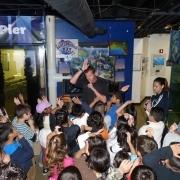Editor’s Note: Vicki Wawerchak, director of the Santa Monica Pier Aquarium, chronicles the process of preparing two sea lion skulls and one harbor seal skull to become marine artifacts on exhibit at the aquarium. This is the second installment of her story of the process. (Read part one: “An Unusual Jackpot“).
I love sharks. I really can’t get enough of them. A previous job allowed me to swim with blues and makos both in and out of a cage, and I recently felt the size of a flea as I swam next to a pregnant 35-foot whale shark in the Galapagos. I’ve had the opportunity to swim with oceanic white tips and nurse sharks and I’m waiting for the day when I can get into a cage to observe the almighty landlord, a white shark.
But…put me in the same room as a bug and I am not a happy person. Not all bugs, mind you, but most of them. Oh sure, I appreciate their ecological niche and the role they play in the overall food web but that is about as far my appreciation goes. So the thought of having a bug box here to slowly work on removing skin and tissue from our newly donated skulls, made me a bit nervous. Jose [Bacallao, the aquarium’s senior aquarist] and I talked about using dermestid beetle colonies as a method of prep and even referenced the great job the California Science Center did on making a whole exhibit surrounding this subject. Could we make an exhibit out of this too? Should we just keep it behind the scenes? Either way, I couldn’t stop thinking about what would happen if the beetle box broke and the colony was left to run amok in the aquarium waiting for my arrival. But scientifically, I knew that if this were the best method of prep, I would get over it. We both decided to wait for our artifacts to arrive so we could see the skull size we would be working with and how much flesh and skin needed to be removed.
Again, I sat by the window jumping at every squeaky-braked truck I heard outside my office in anticipation of the Fed Ex truck. I was channeling Ralphie from “A Christmas Story” waiting for my official Red Ryder, carbine action, 200-shot range model air rifle. As I counted down the days for my delivery, I read the Marine Mammal Skeletal Preparation and Articulation document that was passed to me by our friends at The Marine Mammal Center. This helped me weigh the pros and cons of the various prep techniques and helped us narrow the options. At last, my delivery truck arrived with a cooler and we wheeled it into the back and opened it, exposing the contents.
“Oh gosh….it looks like a scene from Dexter.”
No one said science was pretty.
Wrapped in baggies were three frozen skulls with skin, fur and other features in tact. (I truly never overlook the fact that these were once alive, swimming around in the ocean and I keep that thought and respect for these animals with me always.) We studied the skulls in detail–measuring up their size, observing thickness of the skin and examining the amount of fur we would have to work through to get a clean skull. We put them back in the freezer and brainstormed what we would do next.
We began to consider maceration, removing tissue by soaking the skulls in liquid. Freshwater maceration didn’t seem like the answer—this method consists of removing flesh prior to fresh water submersion as well as continued monitoring of water level in buckets. Boiling also seemed to be out of the question as it usually follows maceration. We also thought it would be difficult to find a kitchen that wouldn’t mind hosting us and filling their space with a, er, lingering odor. Burying the skulls would be tough. Living under a pier, something else might get to it first and beetles, with all my feelings aside, didn’t seem like the right choice for us either. Instead, the light bulb went off and since we are surrounded by salt water we decided to go the way of saltwater maceration.
(For how to clean a skull, read part three )
Photo: jkirkhart35 via Flickr



